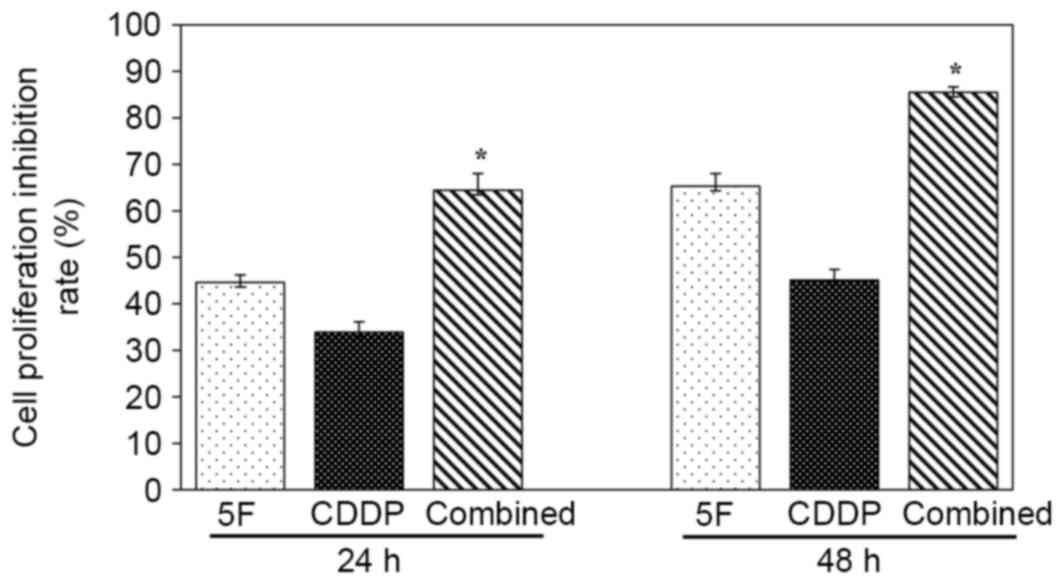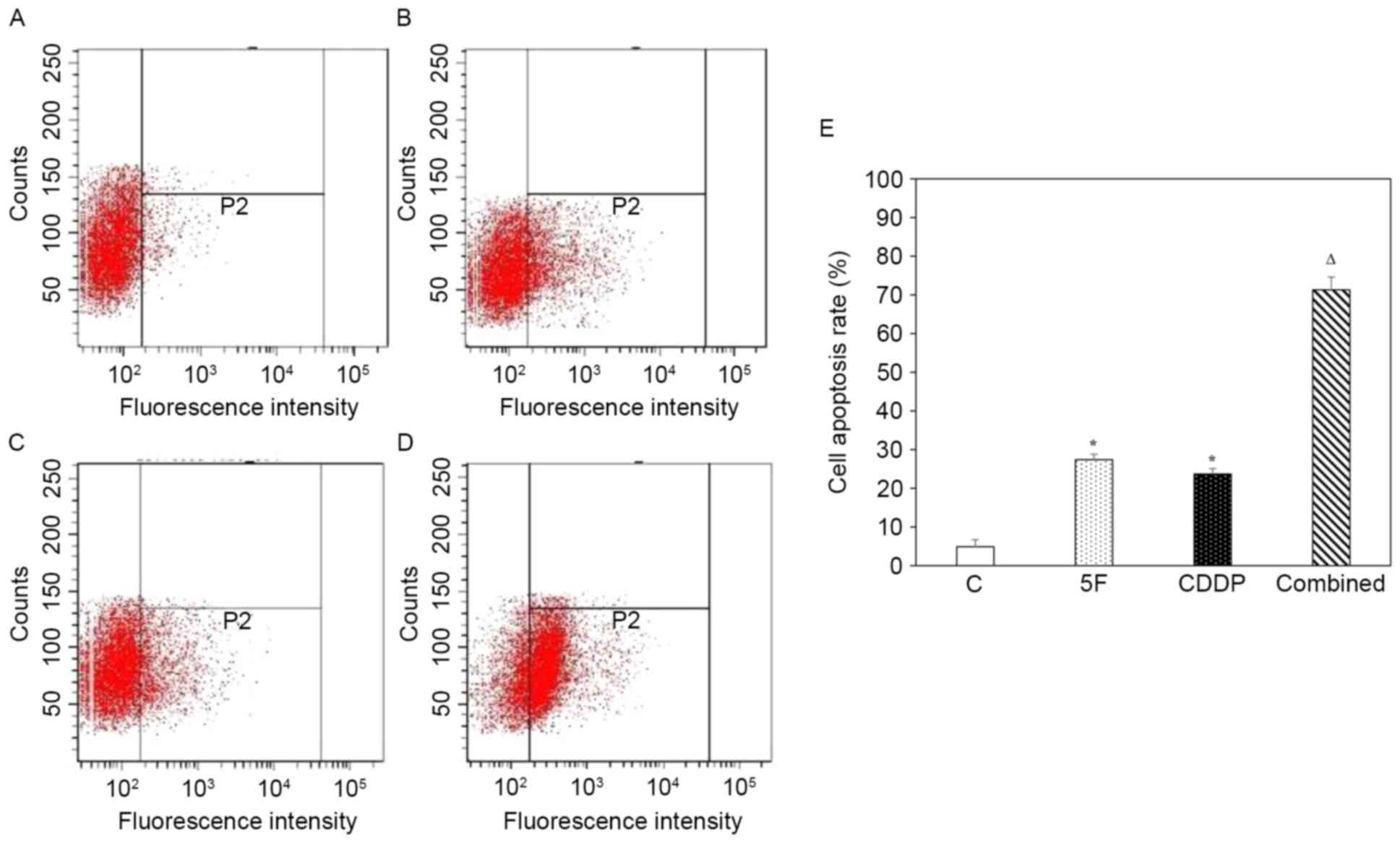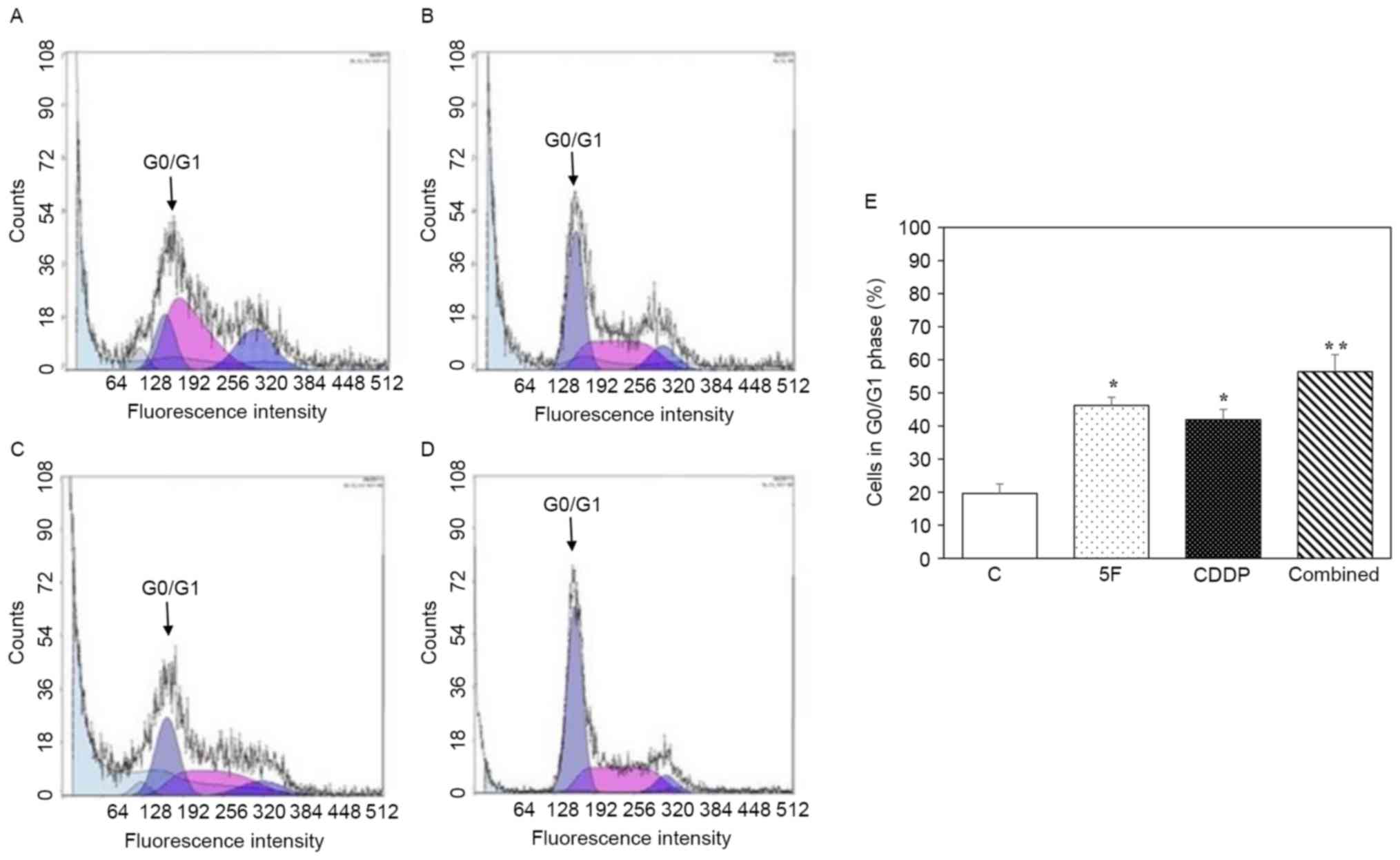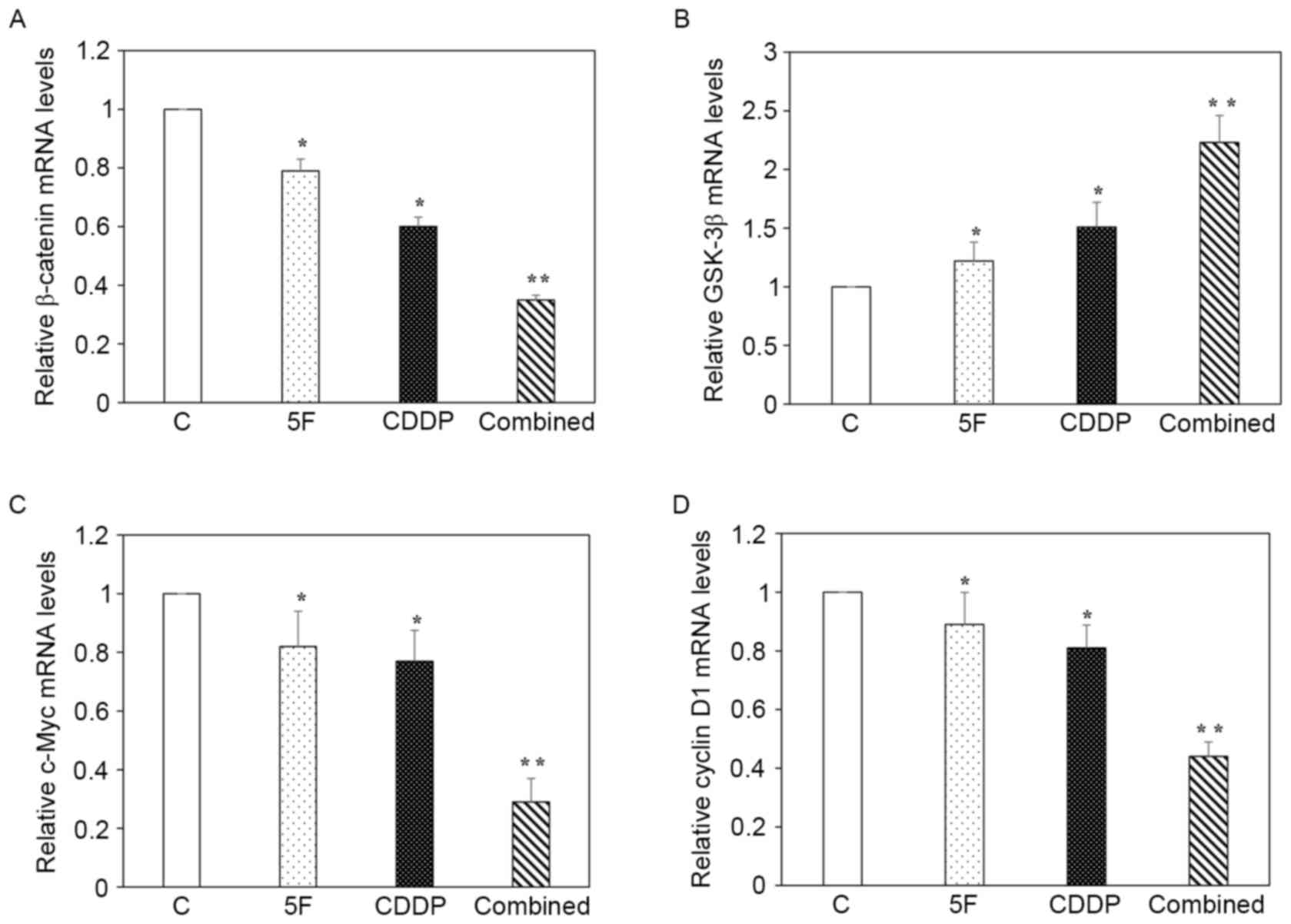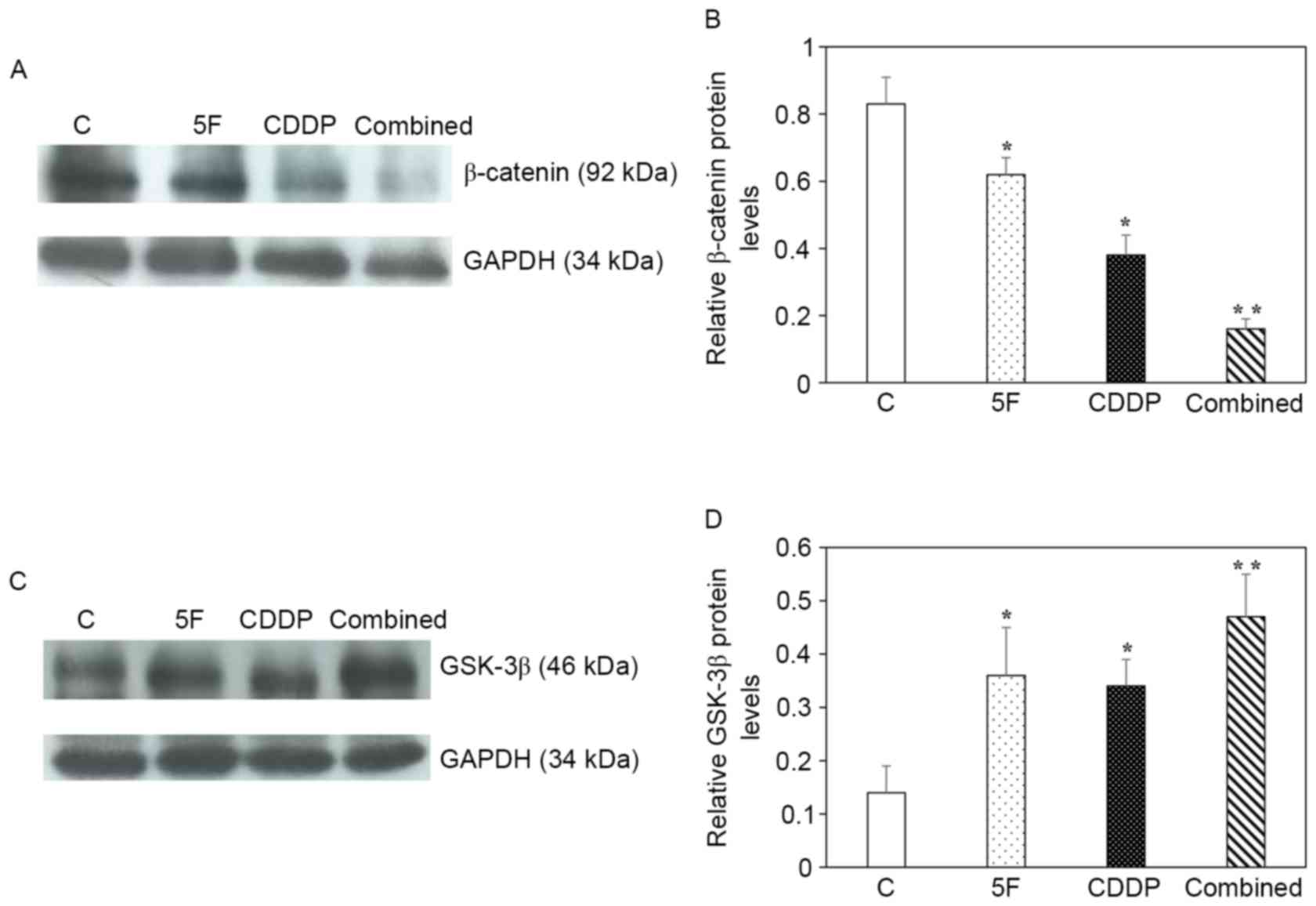Synergistic anti‑proliferative and pro‑apoptotic activities of 5F and cisplatin in human non‑small cell lung cancer NCI‑H23 cells
- Authors:
- Published online on: August 28, 2017 https://doi.org/10.3892/ol.2017.6848
- Pages: 5347-5353
-
Copyright: © Li et al. This is an open access article distributed under the terms of Creative Commons Attribution License.
Abstract
Introduction
Non-small cell lung cancer (NSCLC) accounts for 85% of all cases of lung cancer and is the leading cause of cancer-associated mortality worldwide (1). While surgery is the mainstay of treatment for early-stage and localized NSCLC, combination chemotherapy is considered the standard of care for patients with advanced NSCLC (1,2). Combination chemotherapy frequently uses two drugs, which often includes cisplatin plus one other drug (3–5). Cisplatin, also termed cis-diamminedichloroplatinum II (CDDP), is a platinum-containing compound that has also been used for the treatment of other human cancers, including head and neck, ovarian, breast, bladder, and testicular cancers (6–9). To improve the treatment of late-stage NSCLC, clinical trials of three-drug combinations have been performed (10). However, the results of these trials have demonstrated that adding a third drug may add little benefit as a result of the increased toxicity (11,12). Therefore, the search for novel drugs that are just as effective with less toxicity associated remains vigorous.
Ent-11α-hydroxy-15-oxo-kaur-16-en-19-oic acid (5F), a bioactive compound isolated from the herb Pteris semipinnata L., has been shown to induce cell apoptosis and inhibit cell proliferation in various cancer cells, including thyroid carcinoma, lung cancer, nasopharyngeal carcinoma and hepatocellular carcinoma cells (13–18). CDDP and 5F inhibit cancer cell growth by inducing cell apoptosis (9,14–16). In view of these findings, it was hypothesized that 5F and CDDP may have synergistic anticancer activity in human NSCLC cells. The present study was therefore conducted to examine the effects of 5F combined with CDDP on cell growth, cell apoptosis, cell cycle arrest and regulation of gene expression in NCI-H23 cells.
Materials and methods
Drugs
CDDP was purchased from Qilu Pharmaceutical Co., Ltd. (Jinan, China). 5F was isolated from Pteris semipinnata L. as previously described (13), and the purity was >99%, as analyzed by high-performance liquid chromatography (19). A stock solution of CDDP at 1 mg/ml was prepared with PBS (pH 7.4). A stock solution of 5F at 2 mg/ml was prepared by dissolving 5F in dimethyl sulfoxide (DMSO).
Cell growth inhibition analysis
Human NSCLC NCI-H23 cells (American Type Culture Collection; Manassas, VA, USA) were cultured in RPMI-1640 medium supplemented with 10% fetal bovine serum, 100 U/ml penicillin and 100 µg/ml streptomycin (all from Gibco; Thermo Fisher Scientific, Inc., Waltham, MA, USA) at 37°C under a humidified atmosphere containing 5% CO2. Cells were detached with 0.25% trypsin/EDTA (Gibco; Thermo Fisher Scientific, Inc.), washed once with PBS and re-suspended at a density of 3×104 cells/ml in RPMI-1640 medium. Cell suspension (100 µl) was seeded onto each well of 96-well plates and cultured at 37°C overnight. On day 2, the culture medium was replaced with fresh medium, and cells were divided into different groups and treated as follows: CDDP group, 5 µg/ml of CDDP (final concentration); 5F group, 40 µg/ml of 5F (final concentration); combination group, 5 µg/ml of CDDP and 40 µg/ml of 5F (final concentration); and control group, no drug added. Each group was analyzed in triplicate. Following the addition of drugs, cells were cultured at 37°C for 24 or 48 h, and an MTT assay was performed according to the manufacturer's protocol (Beyotime Institute of Biotechnology, Haimen, China). Briefly, the culture medium was replaced with 100 µl of fresh culture medium, and 10 µl MTT (5 mg/ml) was added into each well. Following incubation for 4 h at 37°C, MTT was removed from the wells and 150 µl DMSO was added, followed by agitating the plate for 10 min. Subsequently, the absorbance of each well at 540 nm was measured using a microplate reader (Model 450; Bio-Rad Laboratories, Inc., Hercules, CA, USA). The cell proliferation inhibition rate was calculated as: (Absorbance of control group-absorbance of treatment group)/absorbance of control group.
Cell apoptosis assay
Cell detachment and wash were performed as aforementioned. Subsequently, cells were re-suspended at a density of 1×105 cells/ml in RPMI-1640 medium. Cell suspension (500 µl) was seeded onto each well of 6-well plates. Following culture at 37°C for 24 h, cells were divided into four groups and treated with drugs at 37°C for 48 h as aforementioned. Cell apoptosis was assessed using an Annexin V-FITC Apoptosis Detection kit (Beyotime Institute of Biotechnology, Haimen, China) as advised by the manufacturer. Briefly, cells were detached with PBS/1 mM EDTA, washed once with PBS and re-suspended in 195 µl Annexin V binding buffer from the kit, followed by addition of 5 µl Annexin V-fluorescein isothiocyanate and 10 min, 37°C incubation in the dark. The fluorescence of the apoptotic cells was then determined with a flow cytometer (FACSAria III; BD Biosciences, Franklin Lakes, NJ, USA).
Cell cycle arrest assay
Cells were treated with drugs for 48 h as previously described. Following treatment, cells were detached and washed once with PBS. A total of 1×106 cells were fixed in cold 70% ethanol for 1 h at −20°C. Ethanol was then removed by centrifugation at 1,000 × g at 4°C for 5 min and cells were washed once with PBS. Subsequently, 200 µl of propidium iodide (PI; 50 µg/ml in PBS) was added to the cells and incubated at 4°C for 30 min in the dark. The cell cycle distribution was then determined with a flow cytometer.
Reverse transcription-quantitative polymerase chain reaction (RT-qPCR)
RT-qPCR was performed to determine the relative messenger RNA (mRNA) levels of β-catenin, glycogen synthase kinase (GSK)-3β, cyclin D1 and c-Myc in drug-treated and control cells. Total RNA of NCI-H23 cells was extracted using TRIzol reagent (Takara Biotechnology Co., Ltd., Dalian, China) following the manufacturer's protocol and quantified by photospectrometry (BioSpectrometer; Eppendorf, Hamburg, Germany). Total RNA (2 µg) was reversed transcribed using the PrimeScript RT Reagent kit (Takara Biotechnology Co., Ltd.) according to the manufacturer's protocol. Complementary DNA (1 µl) was mixed with 5 µl of 2X SYBR Premix Taq buffer (Takara Biotechnology Co., Ltd.), 200 nM of each primer (final concentration) and nuclease-free H2O, which was used to adjust the reaction volume to a final volume of 20 µl. Primers for RT-qPCR were designed according to the published gene sequences using Oligo software, version 5.0 (Molecular Biology Insights, Inc., Colorado Springs, CO, USA) and synthesized by Sangon Biotech Co., Ltd. (Shanghai, China). The sequences of all primers, which were based on sequences available from GenBank (https://www.ncbi.nlm.nih.gov/gene/), and relevant information are listed in Table I. The amplification was performed on the LightCycler 480 Instrument II (Roche Diagnostics, Basel, Switzerland) as follows: Stage 1, 95°C for 10 min; and stage 2, 95°C for 10 sec and 60°C for 20 sec. Stage 2 was repeated for 40 cycles. Relative mRNA levels against GAPDH were calculated using the 2−∆∆Cq method (16).
Western blotting
Total protein was extracted from H23 cells using radioimmunoprecipitation assay lysis buffer (Thermo Fisher Scientific, Inc.) and quantified using the Pierce BCA Protein Assay kit (Thermo Fisher Scientific, Inc.) according to the manufacturer's protocol. Total protein (50 µg) was separated by 10% SDS-PAGE and electrotransferred to a nitrocellulose membrane. The membrane was blocked in TBS-Tween-20 (TBST) buffer [50 mM Tris-HCl, 150 mM NaCl (pH 7.5) and 0.1% Tween-20] containing 5% skimmed milk for 1 h at room temperature. Subsequently, the membrane was incubated with primary antibodies diluted in blocking buffer at 4°C overnight. The primary antibodies used were as follows: Mouse anti-human β-catenin monoclonal antibody (dilution 1:1,000, cat. no. 2698) and rabbit anti-human GSK-3β antibody (dilution 1:1,000, cat. no. 9315) (both Cell Signaling Technology, Inc., Danvers, MA, USA). Following incubation with the primary antibodies, the membrane was washed three times with TBST buffer, followed by incubation with horseradish peroxidase-conjugated anti-mouse (dilution 1:5,000, cat. no. L3032-2) or anti-rabbit secondary antibodies (dilution 1:5,000, cat. no. L3012-2) (both Signalway Antibody, College Park, MD, USA) at 4°C for 1 h. Subsequently, the membrane was washed three times with TBST buffer. The specific bands were visualized with an enhanced chemiluminescence western blot analysis detection kit (Beyotime Institute of Biotechnology), and densitometric analysis was performed using Image-Pro Plus 6.0 software (Media Cybernetics, Inc., Rockville, MD, USA) to determine the relative levels of β-catenin and GSK-3β following normalization against GAPDH. GAPDH, serving as a loading control, was probed using a rabbit anti-human GAPDH monoclonal antibody (cat. no. 2118, dilution 1:3,000; Cell Signaling Technology, Inc.).
Statistical analysis
All data are expressed as the mean ± standard deviation. Statistical analysis of the differences between multiple groups was performed by one-way analysis of variance using the SPSS 13.0 software (SPSS, Inc., Chicago, IL, USA). Additional two-group comparisons were performed using the least-significant difference test. P<0.05 was considered to indicate a statistically significant difference.
Results
Synergistic anti-proliferative effects of 5F and CDDP
At 24 h after drug treatment, the cell proliferation inhibition rate for the combined group was 64.5±3.6%, which was significantly higher than that of the 5F (44.6±1.6%; P<0.05; n=4) and CDDP (33.9±2.2%; P<0.05; n=4) groups (Fig. 1). When cells were treated for 48 h, the inhibition rates for the combined, 5F and CDDP groups were 85.5±1.2, 65.3±2.7 and 45.1±2.3%, respectively (P<0.05 compared with the combined group; n=4) (Fig. 1).
Synergistic pro-apoptotic effects of 5F and CDDP
Representative histograms of cell apoptotic analysis by flow cytometry for the control, 5F, CDDP and combined groups are shown in Fig. 2A-D, respectively. The apoptotic rates for the control, 5F, CDDP and combined groups were 4.9±1.8, 27.4±1.4, 23.7±1.4 and 71.3±3.3%, respectively. Treatment with 5F or CDDP alone markedly increased cell apoptosis compared with that of no-drug treatment (P<0.05). Statistical analysis revealed that the combined group had a significantly higher apoptotic rate than the 5F (P<0.001; n=6) and CDDP (P<0.001; n=6) groups (Fig. 2E).
Synergistic cell cycle arrest effects of 5F and CDDP
PI staining and flow cytometric analysis were employed to determine cell numbers at each phase of the cell cycle following drug treatment. Fig. 3A-D shows representative histograms of cytometric analysis of the cell cycle for the control, 5F, CDDP and combined groups, respectively. As demonstrated in Fig. 3E, treatment with 5F or CDDP alone caused cell cycle arrest at the G0/G1 phase. When cells were incubated with 5F combined with CDDP, the percentage of cells at the G0/G1 phase was 56.4±5.2%, which was significantly higher than that of the 5F (46.2±2.5%; P<0.05; n=6) and CDDP (41.9±3.1%; P<0.05; n=6) groups.
Synergistic effects of 5F and CDDP on the regulation of β-catenin, GSK-3β, c-Myc and cyclin D1
Fig. 4 shows the RT-qPCR data (n=6 for each gene). The results revealed that treatment with 5F or CDDP alone resulted in reduced mRNA expression of β-catenin, c-Myc and cyclin D1, but increased mRNA expression of GSK-3β. When compared with that of the 5F or CDDP group, the combined group had a significantly lower level of β-catenin, c-Myc and cyclin D1, but a markedly higher level of GSK-3β (Fig. 4A-D). Western blot analysis of β-catenin and GSK-3β was performed (Fig. 5A and B, respectively), and statistical analysis of β-catenin and GSK-3β protein levels (Fig. 5C and D, respectively) confirmed the mRNA data for β-catenin and GSK-3β.
Discussion
CDDP-based combination chemotherapy has been shown to be effective in improving survival and quality of life in patients with advanced NSCLC (4,5). Recently, the identification of abnormal molecular pathways in a number of NSCLC cases has led to the development of targeted therapies for a subset of patients (20,21). However, >50% of patients with advanced NSCLC are usually treated with combination chemotherapy (20). In the past two decades, several anticancer drugs, including gemcitabine, vinorelbine, paclitaxel, docetaxel, pemetrexed and vinblastine, have been developed and combined with CDDP to form a doublet therapy regimen (22). Over the last decade, the 5-year survival rate of patients with advanced NSCLC has only marginally improved with combination therapy (20). To improve the treatment of advanced NSCLC, clinical trials using three-drug combinations have been performed (10). However, the results show that adding a third drug does not add much benefit due to increased toxicity (11,12). Therefore, the search for novel drugs that are just as effective but with less toxicity remains vigorous (2,22).
5F has been shown to induce apoptosis and inhibit cell proliferation in various cancer cells (14–18). One outstanding property of 5F is its minimal side effects (14), making it a promising anticancer agent. In a preliminary experiment, the half-maximal inhibitory concentration (IC50) for CDDP and 5F was determined in H23 cells (data not shown). In the present study, a final concentration of 5F of 40 µg/ml and of CDDP of 5 µg/ml, which was close to their IC50, was selected to treat H23 cells. It was observed that 5F and CDDP synergistically induced apoptosis and inhibited cell growth, arrested cell cycles in the G0/G1 phase, and regulated the expression of β-catenin, GSK-3β, c-Myc and cyclin D1 genes.
Liu et al (15) observed that treatment of thyroid carcinoma cells with 5F led to the translocation of B-cell lymphoma-2-associated X protein into mitochondria, and the release of cytochrome c and apoptosis-inducing factor from mitochondria into the cytosol, indicating that the cell death induced by 5F was through a mitochondrial-mediated pathway. It is known that the anticancer activity of CDDP is associated with its ability to interact with the purine bases of DNA, causing DNA damage and subsequently inducing apoptosis in cancer cells (9,23). Therefore, 5F and CDDP likely exert synergistic anticancer effects in H23 cells through targeting different pathways, although the mechanisms behind these interactions were not elucidated in the present study.
The Wnt signaling pathway was first identified due to its role in carcinogenesis (24). Activation of the canonical or Wnt/β-catenin-dependent signaling pathway in numerous cases promotes cell growth. It has been reported that the Wnt signaling pathway is activated in ~50% of human NSCLC cell lines and primary tumors, and downregulation of activated Wnt signaling inhibits NSCLC proliferation and induces a more differentiated phenotype (21). Wnt ligands initiate pathway activation by binding to the Frizzled receptor on the cell membrane. Subsequently, the signal is transduced to the cytoplasmic phosphoprotein Dishevelled (Dsh) (25,26). Once Dsh is activated, it leads to the accumulation and stabilization of β-catenin. Subsequently, β-catenin is translocated into nuclei, where it modulates target gene expression, including upregulation of cyclin D1 and c-Myc, to stimulate cell proliferation (27,28). GSK-3β negatively regulates the Wnt signaling pathway by destabilizing β-catenin and inhibiting β-catenin accumulation (28). Overexpression of cyclin D1 and c-Myc has been revealed to be associated with cancer onset and progression (29–32). The present study revealed that 5F and CDDP concurrently downregulated β-catenin but upregulated GSK-3β in H23 cells, leading to reduced expression of cyclin D1 and c-Myc, which may represent one of the mechanisms for the synergistic anticancer activity of 5F and CDDP. In addition, as cyclin D1 is required for progression through the G1 phase of the cell cycle, reduced cyclin D1 levels may also be responsible for G0/G1 cell cycle arrest resulting from 5F and CDDP treatment.
Considering that 5F exerts anticancer activity with minimal side effects, future studies should investigate whether combination of 5F and CDDP will have the same or greater anticancer activity but with less side effects compared with that of CDDP plus one other drug, and whether addition of 5F as a third drug to CDDP-based two-drug combinations will enhance the anticancer effects without increasing toxicity. To address these questions, in vivo studies using animal models of NSCLC are required.
Acknowledgements
The present study was supported by the Foundation for Distinguished Young Talents in Higher Education (grant no. LYM10083) and the Science and Technology Planning Project (grant no. 2011B031800343) of Guangdong Province, China.
References
|
Boolell V, Alamgeer M, Watkins DN and Ganju V: The evolution of therapies in non-small cell lung cancer. Cancers (Basel). 7:1815–1846. 2015. View Article : Google Scholar : PubMed/NCBI | |
|
Ramalingam S and Belani C: Systemic chemotherapy for advanced non-small cell lung cancer: Recent advances and future directions. Oncologist. 13 Suppl 1:S5–S13. 2008. View Article : Google Scholar | |
|
Schiller JH, Harrington D, Belani CP, Langer C, Sandler A, Krook J, Zhu J and Johnson DH: Eastern Cooperative Oncology Group: Comparison of four chemotherapy regimens for advanced non-small-cell lung cancer. N Engl J Med. 346:92–98. 2002. View Article : Google Scholar : PubMed/NCBI | |
|
Cullen MH, Billingham LJ, Woodroffe CM, Chetiyawardana AD, Gower NH, Joshi R, Ferry DR, Rudd RM, Spiro SG, Cook JE, et al: Mitomycin, ifosfamide, and cisplatin in unresectable non-small-cell lung cancer: Effects on survival and quality of life. J Clin Oncol. 17:3188–3194. 1999. View Article : Google Scholar : PubMed/NCBI | |
|
Billingham LJ and Cullen MH: The benefits of chemotherapy in patient subgroups with unresectable non-small-cell lung cancer. Ann Oncol. 12:1671–1675. 2001. View Article : Google Scholar : PubMed/NCBI | |
|
Creagan ET, Woods JE, Schutt AJ and O'Fallon JR: Cyclophosphamide, adriamycin, and cis-diamminedichloroplatinum (II) in the treatment of advanced nonsquamous cell head and neck cancer. Cancer. 52:2007–2010. 1983. View Article : Google Scholar : PubMed/NCBI | |
|
Colombo N, Sessa C, Landoni F, Sartori E, Pecorelli S and Mangioni C: Cisplatin, vinblastine, and bleomycin combination chemotherapy in metastatic granulosa cell tumor of the ovary. Obstet Gynecol. 67:265–268. 1986. View Article : Google Scholar : PubMed/NCBI | |
|
Decatris MP, Sundar S and O'Byrne KJ: Platinum-based chemotherapy in metastatic breast cancer: Current status. Cancer Treat Rev. 30:53–81. 2004. View Article : Google Scholar : PubMed/NCBI | |
|
Dasari S and Tchounwou PB: Cisplatin in cancer therapy: Molecular mechanisms of action. Eur J Pharmacol. 740:364–378. 2014. View Article : Google Scholar : PubMed/NCBI | |
|
Okamoto I, Miyazaki M, Morinaga R, Kaneda H, Ueda S, Hasegawa Y, Satoh T, Kawada A, Fukuoka M, Fukino K, et al: Phase I clinical and pharmacokinetic study of sorafenib in combination with carboplatin and paclitaxel in patients with advanced non-small cell lung cancer. Invest New Drugs. 28:844–853. 2010. View Article : Google Scholar : PubMed/NCBI | |
|
Han JY, Nam BH, Kim HY, Yoon SJ, Kim HT and Lee JS: A randomized phase II study of irinotecan plus cisplatin versus irinotecan plus capecitabine with or without isosorbide-5-mononitrate in advanced non-small-cell lung cancer. Ann Oncol. 23:2925–2930. 2012. View Article : Google Scholar : PubMed/NCBI | |
|
Paz-Ares L, Mezger J, Ciuleanu TE, Fischer JR, von Pawel J, Provencio M, Kazarnowicz A, Losonczy G, de Castro G Jr, Szczesna A, et al: Necitumumab plus pemetrexed and cisplatin as first-line therapy in patients with stage IV non-squamous non-small-cell lung cancer (INSPIRE): An open-label, randomised, controlled phase 3 study. Lancet Oncol. 16:328–337. 2015. View Article : Google Scholar : PubMed/NCBI | |
|
Li MY, Leung J, Kong AW, Liang NC, Wu K, Hsin MK, Deng YF, Gong X, Lv Y, Mok TS, et al: Anticancer efficacy of 5F in NNK-induced lung cancer development of A/J mice and human lung cancer cells. J Mol Med (Berl). 88:1265–1276. 2010. View Article : Google Scholar : PubMed/NCBI | |
|
Li MY, Liang NC and Chen GG: Ent-11alpha-hydroxy-15-oxo-kaur-16-en-19-oic-acid induces apoptosis of human malignant cancer cells. Curr Drug Targets. 13:1730–1737. 2012. View Article : Google Scholar : PubMed/NCBI | |
|
Liu ZM, Chen GG, Vlantis AC, Liang NC, Deng YF and van Hasselt CA: Cell death induced by ent-11alpha-hydroxy-15-oxo-kaur-16-en-19-oic-acid in anaplastic thyroid carcinoma cells is via a mitochondrial-mediated pathway. Apoptosis. 10:1345–1356. 2005. View Article : Google Scholar : PubMed/NCBI | |
|
Wu K, Liu Y, Lv Y, Cui L, Li W, Chen J, Liang NC and Li L: Ent-11α-hydroxy-15-oxo-kaur-16-en-19-oic-acid induces apoptosis and cell cycle arrest in CNE-2Z nasopharyngeal carcinoma cells. Oncol Rep. 29:2101–2108. 2013. View Article : Google Scholar : PubMed/NCBI | |
|
Ye H, Wu Q, Guo M, Wu K, Lv Y, Yu F, Liu Y, Gao X, Zhu Y, Cui L, et al: Growth inhibition effects of ent-11α-hydroxy-15-oxo-kaur-16-en-19-oic-acid on colorectal carcinoma cells and colon carcinoma-bearing mice. Mol Med Rep. 13:3525–3532. 2016. View Article : Google Scholar : PubMed/NCBI | |
|
Chen GG, Leung J, Liang NC, Li L, Wu K, Chan UP, Leung BC, Li M, Du J, Deng YF, et al: Ent-11α-hydroxy-15-oxo-kaur-16-en-19-oic-acid inhibits hepatocellular carcinoma in vitro and in vivo via stabilizing IkBα. Invest New Drugs. 30:2210–2218. 2012. View Article : Google Scholar : PubMed/NCBI | |
|
Lu Y, Wu K, Liang N and Chen GG: LC method for quantification of ent-11α-Hydroxy-15-oxo-kaur-16-en-19-oic acid in rabbit plasma: Validation and application to a pharmacokinetic study. Chromatographia. 70:15992009. View Article : Google Scholar | |
|
Alamgeer M, Ganju V and Watkins DN: Novel therapeutic targets in non-small cell lung cancer. Curr Opin Pharmacol. 13:394–401. 2013. View Article : Google Scholar : PubMed/NCBI | |
|
Akiri G, Cherian MM, Vijayakumar S, Liu G, Bafico A and Aaronson SA: Wnt pathway aberrations including autocrine Wnt activation occur at high frequency in human non-small-cell lung carcinoma. Oncogene. 28:2163–2172. 2009. View Article : Google Scholar : PubMed/NCBI | |
|
de Castria TB, da Silva EM, Gois AF and Riera R: Cisplatin versus carboplatin in combination with third-generation drugs for advanced non-small cell lung cancer. Cochrane Database Syst Rev: CD009256. 2013.doi: 10.1002/14651858.CD009256.pub2. View Article : Google Scholar | |
|
Byun JM, Jeong DH, Lee DS, Kim JR, Park SG, Kang MS, Kim YN, Lee KB, Sung MS and Kim KT: Tetraarsenic oxide and cisplatin induce apoptotic synergism in cervical cancer. Oncol Rep. 29:1540–1546. 2013. View Article : Google Scholar : PubMed/NCBI | |
|
Nusse R and Varmus HE: Wnt genes. Cell. 69:1073–1087. 1992. View Article : Google Scholar : PubMed/NCBI | |
|
Gao C and Chen YG: Dishevelled: The hub of Wnt signaling. Cell Signal. 22:717–727. 2010. View Article : Google Scholar : PubMed/NCBI | |
|
Wong HC, Bourdelas A, Krauss A, Lee HJ, Shao Y, Wu D, Mlodzik M, Shi DL and Zheng J: Direct binding of the PDZ domain of Dishevelled to a conserved internal sequence in the C-terminal region of Frizzled. Mol Cell. 12:1251–1260. 2003. View Article : Google Scholar : PubMed/NCBI | |
|
Gordon MD and Nusse R: Wnt signaling: Multiple pathways, multiple receptors, and multiple transcription factors. J Biol Chem. 281:22429–22433. 2006. View Article : Google Scholar : PubMed/NCBI | |
|
MacDonald BT, Tamai K and He X: Wnt/beta-catenin signaling: Components, mechanisms, and diseases. Dev Cell. 17:9–26. 2009. View Article : Google Scholar : PubMed/NCBI | |
|
Alao JP: The regulation of cyclin D1 degradation: Roles in cancer development and the potential for therapeutic invention. Mol Cancer. 6:242007. View Article : Google Scholar : PubMed/NCBI | |
|
Diehl JA: Cycling to cancer with cyclin D1. Cancer Biol Ther. 1:226–231. 2002. View Article : Google Scholar : PubMed/NCBI | |
|
Meyer N and Penn LZ: Reflecting on 25 years with MYC. Nat Rev Cancer. 8:976–990. 2008. View Article : Google Scholar : PubMed/NCBI | |
|
Nesbit CE, Tersak JM and Prochownik EV: MYC oncogenes and human neoplastic disease. Oncogene. 18:3004–3016. 1999. View Article : Google Scholar : PubMed/NCBI |



